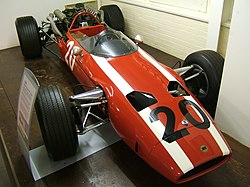Development
The T81 was designed ahead of the 1966 World Championship season to operate within the new 3 litre engine regulations that came into effect that year. It would be powered by Maserati's Tipo 9 2.5-litre V12 engines which had been bored out to 3 litres. These were supplied by the Chipstead Group, Maserati's UK distributors, who had taken control of Cooper in April 1965. [3] Cooper had tested the engine in the interim T80 model.
In many ways the T81 was a typical example of its time, with a rear engine, front radiator, inboard front suspension and a monocoque chassis. In fact the car was Cooper's first monocoque chassis, although by this time such an arrangement had already become standard in Formula 1, having been pioneered by the Lotus 25 four years earlier. The T81 made its race debut in the 1966 Syracuse Grand Prix. [4]
Strenuous efforts were made to save weight for the 1967 season; this lighter car was dubbed the T81B. [5]
Race history
The T81 debuted at the non-championship 1966 Syracuse Grand Prix. The works team was not present but Rob Walker entered a car for Jo Siffert and Guy Ligier entered his own car. Siffert qualified third but retired with a broken universal joint, while Ligier qualified fifth and finished sixth and last.
The World Championship debut was at the 1966 Monaco Grand Prix. Jochen Rindt and Richie Ginther were the works drivers, qualifying in seventh and ninth position respectively. Both retired with mechanical problems. Guy Ligier and Jo Bonnier were also present and finished the race but were unclassified.
With up to three works entries, and three privateer cars, there were suggestions that Cooper were overstretching themselves and that as a result the preparation of the cars was suffering. However John Surtees, who had replaced Ginther after walking out on Ferrari, took the car's first win in the final race of the 1966 season in Mexico, and in turn Surtees's replacement, Pedro Rodríguez, won the very next race, the 1967 season opener in South Africa. The T81B variant was first raced by Rindt at the 1967 Monaco Grand Prix.
Cooper finished third in the Constructors' Championship in 1966 and 1967, their highest placing since 1962, but it would be their last flourish.
The T81's last race came at the start of the 1968 season in South Africa in the hands of privateers Jo Siffert and Jo Bonnier, as by this time the works team had moved on to the T86 chassis. As it happened, Cooper folded at the end of the 1968 season, making the T81 the last Cooper to win a World Championship Grand Prix.
In all the T81 (and T81B) was entered a total of 85 times in its 21 race lifespan, achieving 2 wins, 1 pole position, 6 podiums, and 23 points finishes, earning 74 points in total.
This page is based on this
Wikipedia article Text is available under the
CC BY-SA 4.0 license; additional terms may apply.
Images, videos and audio are available under their respective licenses.
